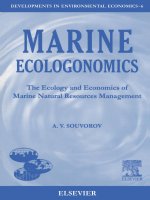the agriculture and economics of peru
Bạn đang xem bản rút gọn của tài liệu. Xem và tải ngay bản đầy đủ của tài liệu tại đây (32.56 KB, 2 trang )
Peru's gross domestic product in the late 1980s was $19.6 billion, or
about $920per capita. Although the economy remains primarily
agricultural, the mining andfishing industries have become increasingly
important. Peru relies primarily on theexport of raw materials-chiefly
minerals, farm products, and fish meal-to earnforeign exchange for
importing machinery and manufactured goods. During thelate 1980s,
guerrilla violence, rampant inflation, chronic budget deficits, anddrought
combined to drive the country to the brink of fiscal insolvency. However,in
1990 the government imposed an austerity program that removed price
controlsand ended subsidies on many basic items and allowed the inti,
the nationalcurrency, to float against the United States dollar. About
35 percent of Peru's working population is engaged in farming. Mostof the
coastal area is devoted to the raising of export crops; on the montaña and
thesierra are mainly grown crops for local consumption. Many farms in
Peru are verysmall and are used to produce subsistence crops; the
country also has largecooperative farms. The chief agricultural products,
together with the approximateannual yield (in metric tons) in the late
1980s, were sugarcane (6.2 million),potatoes (2 million), rice (1.1 million),
corn (880,000), seed cotton (280,000),coffee (103,000), and wheat
(134,000). Peru is the world's leading grower of coca,from which the drug
cocaine is refined. The livestock population included about 3.9 million
cattle, 13.3 millionsheep, 1.7 million goats, 2.4 million hogs, 875,000
horses and mules, and 52million poultry. Llamas, sheep, and vicuñas
provide wool, hides, and skins. The forests covering 54 percent of
Peru's land area have not beensignificantly exploited. Forest products
include balsa lumber and balata gum,rubber, and a variety of medicinal
plants. Notable among the latter is the cinchonaplant, from which quinine
is derived. The annual roundwood harvest in the late1980s was 7.7
million cu m. The fishing industry is extremely important to the country's
economy andaccounts for a significant portion of Peru's exports. It
underwent a remarkableexpansion after World War II (1939-1945); the
catch in the late 1980s was about5.6 million metric tons annually. More
than three-fifths of the catch is anchovies,used for making fish meal, a
product in which Peru leads the world. The extractive industries figure
significantly in the Peruvian economy. Peruranks as one of the world's
leading producers of copper, silver, lead, and zinc;petroleum, natural gas,
iron ore, molybdenum, tungsten, and gold are extracted insignificant
quantities. Annual production in the late 1980s included 3.3 millionmetric
tons of iron ore; 406,400 metric tons of copper; 2054 metric tons of
silver;203,950 metric tons of lead; and 612,500 metric tons of zinc. About
64.9 millionbarrels of crude petroleum were produced, along with 578.3
million cu m ofnatural gas. Much manufacturing in Peru is on a small
scale, but a number of modernindustries have been established since the
1950s along the Pacific coast.Traditional goods include textiles, clothing,
food products, and handicrafts. Itemsproduced in large modern plants
include steel, refined petroleum, chemicals,processed minerals, motor
vehicles, and fish meal. In the late 1980s Peru had an installed
electricity-generating capacity ofapproximately 3.7 million kw, and annual
output was approximately 14.2 billionkwh. About three-quarters of the
total electricity produced was generated inhydroelectric facilities. The
unit of currency in Peru is the inti, divided into 100 céntimos; afterbeing
allowed to float against the U.S. dollar, the inti fluctuated wildly at
between200,000 and 400,000 to the dollar in mid-1990. The Banco
Central de Reserva delPerú (1922) is the central bank and bank of issue.
All private domestic banks werenationalized in 1987.Exports are more
diversified in Peru than in most South American countries. Theprincipal
exports are petroleum, copper, lead, coffee, silver, fish meal, zinc,
sugar,and iron ore. The chief export markets are the United States,
Japan, Germany,Belgium, Luxembourg, Italy, and Great Britain. Exports
earned about $2.7 billionannually in the late 1980s. The leading imports
of Peru include electrical andelectronic items, foodstuffs, metals,
chemicals, and transportation equipment. Theprincipal sources of these
goods are the United States, Japan, Argentina, Germany,and Brazil.
Imports cost about $2.8 billion annually in the late 1980s. Peru's
system of railroads, highways, and airports has been
expandedconsiderably since World War II. The country's mountains make
surface transportdifficult, however. In the late 1980s Peru had about
69,940 km (about 43,460 mi)of roads, of which 11 percent were paved.
The main artery is a section of the Pan-American Highway, which
traverses Peru from Ecuador to Chile, covering adistance of about 2495
km (about 1550 mi). The Trans-Andean Highway linksLima and Pucallpa.
Peru also has about 2400 km (about 1490 mi) of railroads.
Onetrans-Andean line, the Callao-Huancayo, ascends to some 4815 m
(some 15,800 ft)above sea level, the highest point reached by any
standard-gauge line in the world.The most notable inland waterway is the
Amazon River, which is navigable byship from the Atlantic Ocean to
Iquitos in Peru. Lake Titicaca also serves as awaterway. Leading
Peruvian seaports include Callao, Salaverry, Pacasmayo, Paita,and San
Juan. The country's main international airports are situated near
Lima,Cuzco, Iquitos, and Arequipa. Aeroperú, the national airline, offers
domestic andinternational service. Peru's telephone system, which
was nationalized in 1970, has some 600,000instruments. The country is
served by more than 300 radio stations and 8 televisionstations. In the
late 1980s about 4 million radios and 1.6 million televisionreceivers were
in use. In the same period the country had more than 70
dailynewspapers. Dailies with large circulations included El Comercio,
Expreso, Ojo,and La República, all published in Lima.









